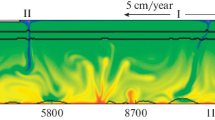Abstract
Theoretical ideas based on the results of numerical modeling of mantle convection are presented. The thermochemical model has taken into consideration such factors as two-layer structure of the mantle, formation of light substance in the D” layer (owing to transition of metallic components into the core), and heavy substances in subduction zones (eclogite-alteration of the oceanic crust). Numerical experiments have shown that this system allows phenomena of global mantle overturns, which make possible to model the general pattern of the Earth’s geologic evolution. The suggested theory establishes cause-effect relationships in the sequence of geological events and is conformed to all the empirical data.
Similar content being viewed by others
References
L. I. Lobkovskii, A. M. Nikishin, and V. E. Khain, Modern Issues of Geotectonics and Geodynamics (Nauchn. mir, Moscow, 2004) [in Russian].
P. Machetel and P. Weber, Nature 350, 55–58 (1991).
P. Tackley, D. Stevenson, G. Glatzmaier, and G. Schubert, Nature 361, 699–704 (1993).
L. I. Lobkovskii and V. D. Kotelkin, “The Two-Level Thermochemical Model of Convection in Mantle and Its Geodynamical Consequences”, in Issues of Global Geodynamics. Proc. Teoretical Seminar of the DGGGGS RAN 1998–1999 (Geos, Moscow, 2000).
V. D. Kotelkin and L. Lobkovsky, Rus. J. Earth. Sci. 6, 385–389 (2004).
V. D. Kotelkin and L. I. Lobkovskii, Fiz. Zemli, No. 1, 26–44 (2007) [Izv. Phys. Solid Earth 43, 24–41 (2007)].
K. D. Litasov, E. Ohtani, A. Sano, et al., Earth and Planet. Sci. Lett. 238, 311–328 (2005).
A. V. Vityazev and G. V. Pechernikova, “Origin of Geospheres: New Results and Remained Issues”, in Tr. Institute of Geosphere Dynamics of the Russian Academy of Sciences. Geophysical Processes in Lower and Upper Spheres of the Earth (IDG RAN, Moscow, 2003) [in Russian].
F. H. Busse, J. Fluid Mech. 72, 67–85 (1975).
A. M. Nikishin, V. E. Khain, and L. I. Lobkovskii, Dokl. Akad. Nauk 323, 519–522 (1992).
N. O. Sorokhtin and O. G. Sorokhtin, Dokl. Akad. Nauk 354(2), 234–237 (1997).
V. E. Khain and M. A. Goncharov, Geotektonika, No. 5, 3–24 (2006) [Geotectonics 40, 327–344 (2006)].
Yu. M. Pushcharovskii, “The Principal Tectonical Asymmetry of the Earth: the Pacific and Indo-Atlantic Segments and Their Interrelations,” in Tectonical and Geodynamical Phenomena (Nauka, Moscow, 1997), pp. 8–24.
M. Stein and A. W. Hofmann, Nature 372, 63–68 (1994).
K. C. Condie, Earth and Planet. Sci. Lett. 168, 97–108 (1998).
Author information
Authors and Affiliations
Corresponding author
Additional information
Original Russian Text © V.D. Kotelkin, L.I. Lobkovskii, 2011, published in Doklady Akademii Nauk, 2011, Vol. 438, No. 3, pp. 365–368.
Rights and permissions
About this article
Cite this article
Kotelkin, V.D., Lobkovskii, L.I. Thermochemical theory of geodynamical evolution. Dokl. Earth Sc. 438, 622–626 (2011). https://doi.org/10.1134/S1028334X11050333
Received:
Published:
Issue Date:
DOI: https://doi.org/10.1134/S1028334X11050333




